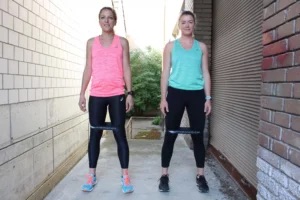Knee pain is a frequent problem among runners. In this post, we highlight four common knee problems – ‘runner’s knee’, ‘jumper’s knee’, bursitis and pes anserinus syndrome. We explain the causes and offer valuable tips on treatment and prevention so you can run pain-free.
1. Runner’s knee
“Runner’s knee” is a common problem among long-time runners and causes pain on the outside of the knee, especially when running uphill or after 15 to 20 minutes of training. The main cause is inflammation in the tractus iliotibialis, a tendon along the outside of the thigh.
Several factors such as overpronation, poor leg stability, tendon shortening and weak core muscles can contribute.
What can you do about it?
- Rest and recovery: give your knees the needed time to heal.
- Physical Therapy: A physiotherapist can recommend exercises to strengthen the muscles around the knee and improve your movement patterns.
- Shoe choice: Invest in running shoes that fit your running style and foot type.
2. Jumpers Knee
Jumper’s Knee, also known as patellar tendonitis, is a common knee complaint among runners. This painful condition is characterized by inflammation of the patellar tendon, which connects the kneecap to the tibia. It usually occurs due to overuse of the knee joint, especially during activities such as frequent jumping on hard surfaces. Symptoms of Jumper’s Knee include pain, swelling and tension around the patellar tendon.
What can you do about it?
- Reduce stress: avoid heavy jumping and pushing until the tendon heals.
- Exercises to strengthen muscles and flexibility: For example, a good exercise is the following:
3. Bursitis
Bursitis in the knee can cause symptoms similar to osteoarthritis of the knee. Bursae are cavities in the body that are covered with joint lining and produce a fluid to reduce friction and pressure. In the knee joint, bursae can become inflamed with high stress (and friction).
The pain first starts as a dull ache in the front or side of the knee and can later develop into a sharp pain that can be felt even at rest.
What can you do about it?
- Relief: avoid activities that make the pain worse.
- Physical therapy: stretching and strengthening exercises can help reduce inflammation and strengthen surrounding muscles.
4. Pes-Anserinus Syndrome
Pes Anserinus syndrome is a painful irritation of the tendon insertion on the inside of the lower leg, just below the knee joint. This area is called the “goosefoot” because it consists of the tendon insertion of three muscles.
The typical symptoms of pes anserinus syndrome are pain on the inside of the lower leg that intensifies when weight is placed on the knee, such as when climbing stairs, in a squatting position, or after exercise. The discomfort can persist for a long period of time.
What can you do about it?
- Rest and recovery: reduce stress and give the affected muscles time to heal.
- Stretching and strengthening: Targeted stretching and strengthening of the affected muscles can relieve pain. Appropriate exercise:
Create with running.COACH a customized and dynamic running training plan that optimally prepares you for your running goals based on your current fitness level. Try running.COACH free for two weeks after your first login!







